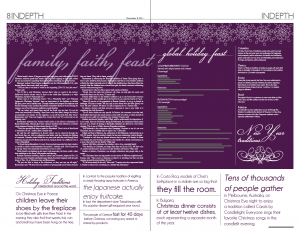Experience holiday traditions around the world.
 Kelly Glueck
Kelly Glueck
-Managing Editor-
Winter break is about 10 degrees away from being here, and while many STLCC Meramec students spend their breaks with Jack Frost nipping at their nose, others are not accustomed to spending their holidays like something out of the movies.
Meramec student Gina Fuentes remembers her first Christmas in the U.S., after leaving Mexico three and a half years prior.
“I will say that it was kind of weird in the beginning. [The U.S. has] the snow.” Fuentes said.
“So it’s like a real Christmas, because that’s what we watch in the movies. Hollywood movies always want to show to the world that Christmas is a white Christmas, and that’s what people see.”
Movies such as “A Christmas Story,” “It’s a Wonderful Life” and “National Lampoon’s Christmas Vacation” have set expectation of the holidays to include BB guns, snow and a holiday ham. Though student and campus life employee and former Montage writer Luelana Bustamante remembers Brazil to be hot during the summer, one of her Christmas traditions sounds familiar.
“We eat turkey and glazed ham and all the foods you eat here. It’s not for winter and everybody’s sweating. I don’t know why they didn’t change the food to accommodate our climate. It’s the opposite, we eat all the food from [the U.S.],” Bustamante said. “Can you imagine how sweaty they were? It’s so hot and we are drinking wine.”
Bustamante attributes her western world cuisine to the diverse colonization of Brazil. Meanwhile, Russian Jews have a historic tradition that references a miracle which happened during the Maccabean Revolt of 2 BC.
“There are special foods that we make for Hanukkah. There’s a lot of fried foods to remember the oil,” student Ilya Lubenko said.
He said the oil’s significance in Jewish culture can be observed through the fried foods they eat, such as sufganiyots and latkes, and also through the lighting of menorah. Lubenko visited Israel for two years and said that even though these traditions are practiced in Russia and the U.S., being in Israel was a different way to observe Hanukkah.
“In Israel during Hanukkah, it’s crazy. Everyone had menorahs lit in their window or outside so others could remember the miracle.” Lubenko said. “All of Israel was just lit up. There were menorahs everywhere, it was so crazy.”
While Israeli’s are lighting up the streets with menorahs, the Latin world is takes their traditions to the streets with parades and dancing.
Brazilian Christmas tradition, similar to other Latin countries, begins on Dec. 24. A close network of family and friends enjoy drinks, food and company until the early hours of Dec. 25, or Christmas day, said Bustamante.
“We put the kids to sleep in the afternoon, so they can stay up all night,” Bustamante said. “We don’t have the tradition of putting milk out for Santa because they see Santa. They talk to Santa, usually.”
Bustamante is referencing the Brazilian tradition of Santa Claus going door to door to give children their presents. Bustamante said that it is her family’s tradition to flicker the lights and make a lot of noise so the children know that Santa Claus has arrived. After the children have received their gifts, the family continues celebrating until the early morning hours.
Fuentes knows what it is like to party until sunrise in Mexico.
“People close the roads and someone will come out and play live music and everybody dances on the street,” Fuentes said.
Fuentes added that it is her family’s tradition to go to the beach after everyone else winds down. They usually get to the beach at 5 a.m. and stay until 4 or 5 p.m.
“About 99 percent of the population is Roman Catholic, so we go to church at midnight. We pray at home. We [act out] a story about how the baby [Jesus] was born. We have a dinner. We dance. It’s like a big party for us,” Fuentes said.
In Mexico, Fuentes said that everyone it expected to wear a new outfit. It is something they look forward to.
“For us, those clothes are very special. In Mexico, the economy is not that bad, but families don’t have that much money to buy stuff very often, so when the kids in town get a new outfit, it’s something very exciting.” Fuentes said.
Student and devote Muslim, Asad Ullah, said he understands the importance of a new outfit. After the Eid Prayer during Eid Mubarak, the celebration which marks the end of a month of fasting or Ramadan, Muslims are allowed to wear festive clothing. This is one of Ullah’s favorite Ramadan traditions.
“Eid Mubarak is the celebration after Ramadan I hesitate to say it’s our own Christmas, but it’s a holiday that we enjoy a lot,” Ullah said.
Ulllah said that in Pakistan, the celebration of Eid Mubarak could include up to 200-300 people. Since his mother’s death, he has been celebrating with his friends.
“I hesitate to call them my friends because they’re more of a family. In Islam your friends are your brothers and sisters; your family. It’s a family environment; in a sense I have Eid with my family,” Ullah said.
Student Lilly Miro celebrates the holidays with a close, extended family.
“Our families, in Colombia, are larger than they are [in the U.S.]. We have a lot of cousins and they grow up close to us, like brothers and sisters,” Miro said.
Similar to Mexico, Colombia is an all-night celebration that people take to the streets.
“For Christmas there are big parades on the streets of different neighborhoods.” Fuentes said. “They aren’t as elaborate as Macy’s or anything, but there are kids running around blowing bubbles. It’s fun.”
“It’s all about family in the end,” Miro said. “I cannot stress how important family is. Family is valued over everything on a holiday like Christmas.”










